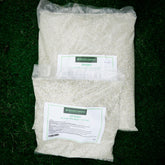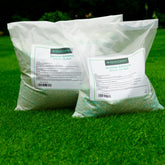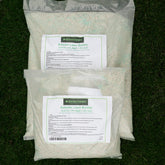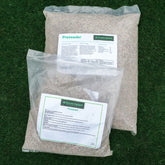The beginners guide on fertilising your lawn (Full guide)
The Complete Lawn Fertilising Course
Step-by-Step Training for Beginners
This is a complete, step-by-step guide to feeding your lawn properly. We've broken down everything from measuring your lawn to choosing the right spreader and applying fertiliser evenly.
Follow this guide and you'll understand exactly what you're doing - no more guesswork, no more wasted money on products that don't work properly.
By the end, you'll know more about how to feed a lawn properly than 98% of other people.
Why is this free?
Because we want you to be part of the iGrow Carpet community, and you deserve the same expert knowledge we use ourselves to grow amazing lawns.
Course Modules
Introduction to Lawn Fertilising
Feeding your lawn might seem simple, but doing it the right way makes all the difference between patchy grass and a lush, green carpet you can be proud of. In this module, we'll cover why proper fertilising matters and what we'll be teaching you throughout this course.
Course Overview
A quick introduction to what we'll be covering in this complete training course.
Why Accurate Measurements Matter
Before you can fertilise properly, you need to know exactly how much lawn you're dealing with. This lesson explains why guessing leads to expensive mistakes.
✅ Module 1 Knowledge Check
Test what you've learned before moving on
Why is accurate lawn measurement so important?
Measuring Your Lawn
It's important to know the size of your lawn so you can order the right amount of fertiliser. This module covers three different methods, from high-tech to basic, so you can choose what works best for your situation.
Using the iGrow Carpet Lawn Measuring Tool
iGrow Carpet has its own measuring tool, powered by Google Maps. It works great for most lawns—unless your garden isn't on Google or it's hidden under thick trees.
1. Type your address into the search bar
2. Click "Draw Your Lawn" to begin outlining
3. Click on the map to create points (minimum 3)
4. Close the shape by clicking the first point
5. Repeat for additional lawn areas
6. View total area and required fertiliser amount
The Basic Method - Pacing It Out
Pacing your lawn is quick, but it's not the most accurate method. Everyone's stride is different, and it's easy to miscount or go off in a slightly wonky line. It's handy for a rough estimate, or if your lawn isn't on Google.
Using Markers to Divide Your Lawn
This method works well if your lawn isn't on Google and has an odd shape. Measuring your lawn into smaller areas and then adding them all up takes a little longer but can be more accurate than pacing.
✅ Module 2 Knowledge Check
Test what you've learned before moving on
What are the three methods for measuring your lawn covered in this module?
Understanding Spreaders
Now you know the size of your lawn, it's time to look at how to apply fertiliser. We tested different spreaders at various price points to help you find one that works well for your needs and budget.
Spreader Options Overview
Here's a quick look at some of the most popular types of spreaders. We particularly like the Einhell battery-powered spreader - you'll see why later in the course.
✅ Module 3 Knowledge Check
Test what you've learned before moving on
What factors should you consider when choosing a spreader?
Calibrating Your Spreader
Calibrating your spreader means setting it up to apply the right amount of fertiliser - not too much, not too little. If you skip this step, you could end up with patchy results, waste money on product, or even burn your lawn.
Introduction to Calibration
What works for one person might not work for the next, depending on walking speed and technique. This lesson covers why calibration is essential and how to approach it.
Jump to Your Spreader Type
Click the spreader you own to jump straight to its calibration guide:
Or scroll down to watch all spreader calibration guides ↓
Calibrating: Budget Spreader
Our cheapest spreader option - perfect for small lawns and tight budgets. Here's how to calibrate it properly.
Calibrating: Mid-Range Spreader
A step up in quality and features while still being affordable. This is a good all-rounder for most lawns.
Calibrating: Battery-Powered Spreader
The Einhell battery-powered spreader - our favourite option. It makes the job faster and more consistent, especially on larger lawns.
Hand Spreaders Roundup
A comprehensive look at various hand spreader options, their pros and cons, and calibration tips for each.
Calibrating: Push Spreader
Push spreaders are excellent for medium to large lawns. They give consistent coverage and are easier on your arm than hand spreaders.
✅ Module 4 Knowledge Check
Test what you've learned before moving on
Why do you need to calibrate your spreader?
Professional Application Techniques
This is something we see all the time - people being told incorrect methods of applying fertiliser. Here's how the professionals do it, and the common mistakes you need to avoid.
What Most People Get Wrong
Before we show you the right way, let's look at the most common mistakes that waste fertiliser and create uneven results.
Never Do This
This is a critical mistake that can damage your lawn and waste product. Learn what NOT to do when filling your spreader.
The Professional Application Method
The bit you've been waiting for - actually getting the fertiliser onto the lawn properly. Remember the golden rule: throw it to your footprints at half rate.
Post-Application Care
This doesn't always need to be done straight away, but the sooner you do it, the quicker you'll see results.
Final Pro Tip
This one's simple but so often forgotten. A small change that can make a big difference to your results.
✅ Module 5 Knowledge Check
Test what you've learned before completing the course
What is the "golden rule" for professional fertiliser application?
🎉 Congratulations! You've Completed the Course
You now know more about proper lawn fertilising than 98% of homeowners. You've learned professional techniques that lawn care companies charge hundreds for, and you got it all free.
Go put this knowledge into action - your lawn will thank you for it!









